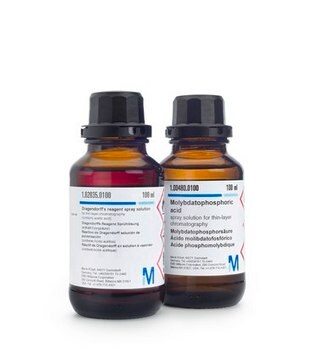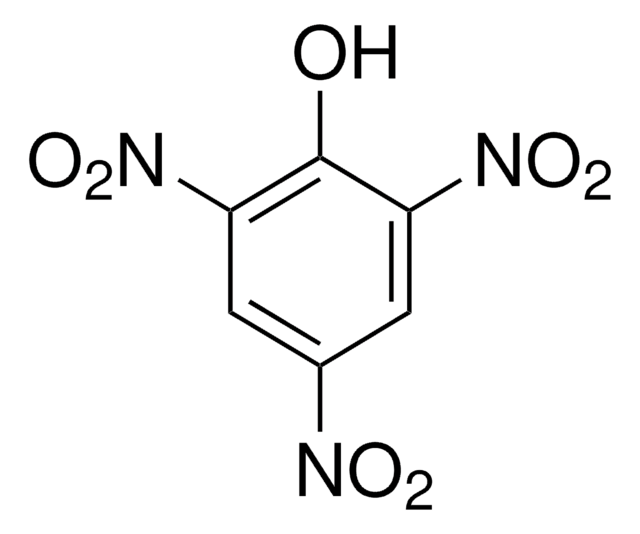44578
Dragendorff reagent
for TLC derivatization
Autenticatiper visualizzare i prezzi riservati alla tua organizzazione & contrattuali
About This Item
Prodotti consigliati
Grado
for TLC derivatization
Livello qualitativo
Composizione
acetic acid
ethyl acetate
sodium iodide
sodium tetraiodobismutate
tecniche
thin layer chromatography (TLC): suitable
InChI
1S/Bi.4HI.K/h;4*1H;/q+3;;;;;+1/p-4
ONBIUAZBGHXJDM-UHFFFAOYSA-J
Applicazioni
- Nematocidal alkaloids from the roots of Stemona mairei: This study explores the use of Dragendorff reagent for the identification of nematocidal alkaloids, demonstrating its critical role in the pharmacological profiling and characterization of natural products (Shi et al., 2023).
- Rapid Detection and Determination of Scopolamine in Black Henbane: Leveraging Dragendorff reagent, this research developed a novel nanosensor for detecting scopolamine, an important application in pharmaceutical analysis and toxicology (Mousavizadeh et al., 2022).
- Proximate analysis and multi spectrometric analysis of Strychnos nux-vomica nuts: The use of Dragendorff reagent in the multi-spectrometric analysis highlights its versatility in chemical synthesis and compound identification, providing essential insights for medicinal chemistry (Ramachandran et al., 2022).
- TLC-MS identification of alkaloids in Leonuri Herba and Leonuri Fructus: This study used Dragendorff reagent to optimize a universal derivatization method, enhancing the detection and analysis of key pharmaceutical compounds in traditional medicine (Zhang et al., 2021).
- Densitometric TLC analysis for control of tropane and steroidal alkaloids in Lycium barbarum: Demonstrates the application of Dragendorff reagent in food chemistry for ensuring the safety and efficacy of herbal supplements through the precise detection of alkaloids (Kokotkiewicz et al., 2017).
Altre note
This non-aqueous Thiess, Reuther and Vagujfalvi variant of the reagent is used to detect alkaloids and other nitrogen compounds in TLC
Avvertenze
Danger
Indicazioni di pericolo
Classi di pericolo
Eye Dam. 1 - Flam. Liq. 2 - Skin Corr. 1B - STOT SE 3
Organi bersaglio
Central nervous system
Codice della classe di stoccaggio
3 - Flammable liquids
Classe di pericolosità dell'acqua (WGK)
WGK 3
Punto d’infiammabilità (°F)
44.6 °F
Punto d’infiammabilità (°C)
7 °C
Dispositivi di protezione individuale
Faceshields, Gloves, Goggles, type ABEK (EN14387) respirator filter
Scegli una delle versioni più recenti:
Possiedi già questo prodotto?
I documenti relativi ai prodotti acquistati recentemente sono disponibili nell’Archivio dei documenti.
I clienti hanno visto anche
Tensammetric studies of the separation of surfactants: Part 1. Investigation of sources of error in precipitation of non-ionic surfactants with modified Dragendorff reagent.
Wyrwas, Bogdan, Andrzej Szymanski, and Zenon Lukaszewski
Analytica Chimica Acta, 278.1, 197-203 (1993)
Feng Qiu et al.
Drug metabolism and disposition: the biological fate of chemicals, 36(11), 2159-2165 (2008-08-16)
The urinary metabolites of berberine, an isoquinoline alkaloid isolated from several Chinese herbal medicines, were investigated in rats and humans. Using macroporous adsorption resin chromatography, open octadecyl silane column chromatography and preparative high-performance liquid chromatography, we isolated seven metabolites (HM1-HM7)
A. Baerheim Svendsen
J. Planar Chromatogr., 2, 8-8 (1989)
Effect of Annona muricata, Abutilon indicum and Evolvulus alsinoides extract on spore germination of sorghum grain mold fungi.
Basha, S. Ameer, A. Sajeli Begum, and G. Raghavendra
International Journal of Bio-resource and Stress Management, 5.1, 102-106 (2014)
W. Funk et al.
J. Planar Chromatogr., 4, 123-123 (1991)
Il team dei nostri ricercatori vanta grande esperienza in tutte le aree della ricerca quali Life Science, scienza dei materiali, sintesi chimica, cromatografia, discipline analitiche, ecc..
Contatta l'Assistenza Tecnica.













